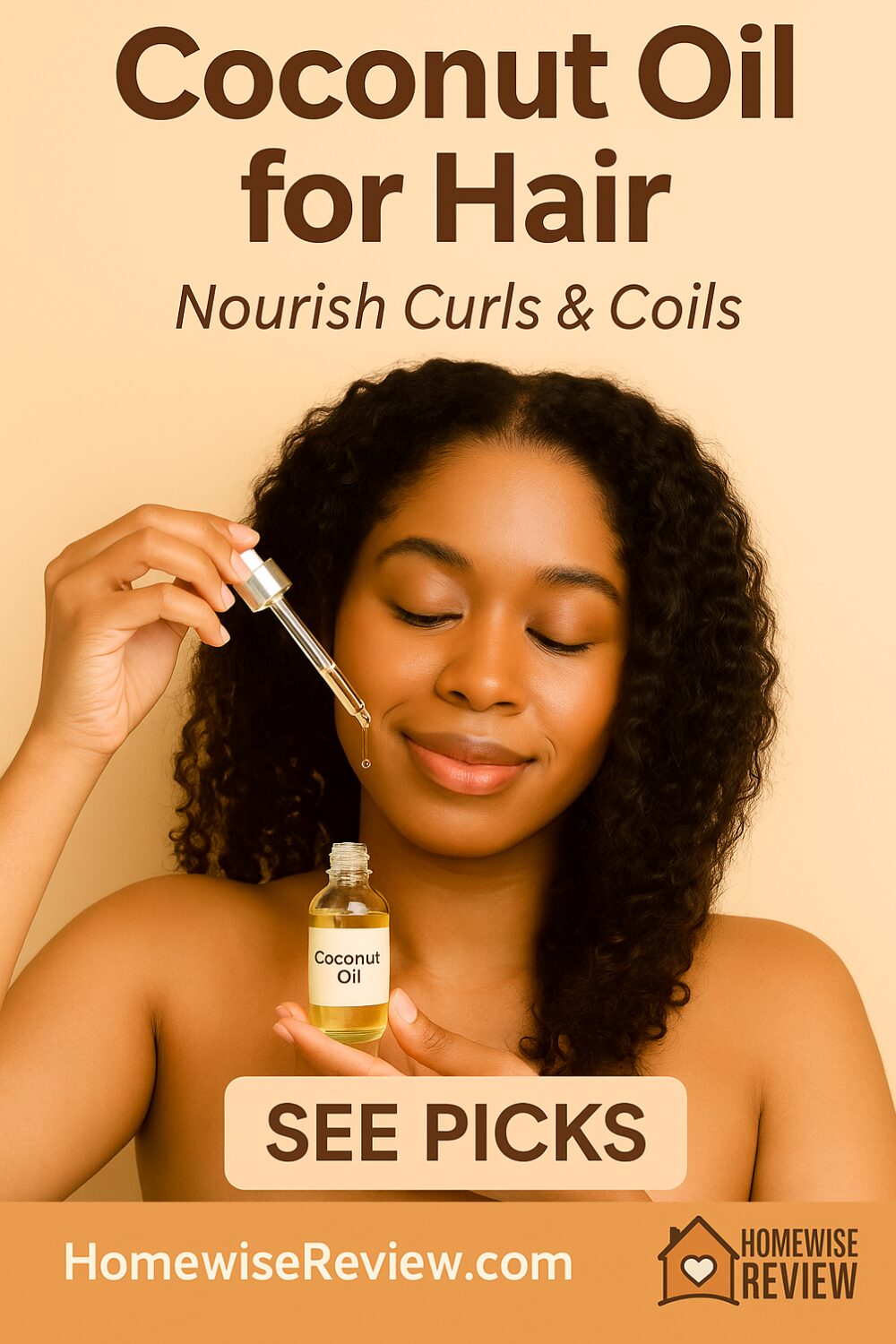
Coconut oil can be a game-changer for dry, porous, or chemically-treated hair because its lauric acid can penetrate the hair shaft and reduce protein loss. Used the right way, it cushions against breakage, boosts slip, and leaves mid-lengths/ends glossy.
But it isn’t a universal cure-all. On very coarse/low-porosity hair, straight coconut oil can feel stiff or waxy; on fine or oily hair, too much can weigh strands down. The secret is choosing the right format (pure vs. lightweight blends) and using it strategically (pre-wash, mid-lengths/ends, tiny amounts).
Quick Picks
| Pick | Why it’s great | Best for | Notes |
|---|---|---|---|
| Viva Naturals Organic Extra-Virgin Coconut Oil | Food-grade, cold-pressed; melts fast; excellent pre-wash mask that reduces protein loss | Dry, damaged, color-treated; medium/high-porosity | Use 1–2 tsp on mid-lengths/ends 30–60 min before shampoo |
| SheaMoisture 100% Extra Virgin Coconut Oil | Thicker butter-like texture for heavy sealing and twist-outs | Coily/very dry hair; protective styles | Warm a pea-size between palms; seal ends or scrunch out crunch |
| OGX Extra Strength Coconut Miracle Oil (Penetrating Oil) | Lightweight silicone + coconut blend for instant shine and frizz control | Fine/normal hair that needs gloss without greasiness | 1–3 drops on damp ends as a leave-in/finisher |
| Briogeo Farewell Frizz Oil (Argan + Coconut + Rosehip) | Featherweight blend that tames flyaways and adds heat protection | Fine to medium hair; frizz-prone | Great daily finisher; won’t feel waxy or heavy |
Ratings reflect a summary of owner feedback and stylist commentary.
How to Use Coconut Oil (Without Grease or Breakage)
1) Pre-wash shield (best overall).
Melt ½–2 tsp in palms and smooth from ear level to ends. Leave 20–60 min, then shampoo and condition. This is the most supported way to reduce protein loss and post-wash roughness.
2) Seal & finish.
After styling, warm a pea-size and tap over ends only. Great on curls/coils to lock in moisture on wash day.
3) Scalp massage (sparingly).
If your scalp is dry, rub 2–3 drops into fingertips and massage for 1–2 minutes, then shampoo. Oily or buildup-prone scalps should skip or keep for pre-wash only.
4) What to avoid.
Daily heavy applications, applying at the roots on fine hair, and mixing with heavy butters if you get buildup easily. Clarify every 1–2 weeks if hair starts to feel coated.
Deep Dives
Viva Naturals Organic Extra-Virgin Coconut Oil
Why we like it: Cold-pressed, food-grade EVCO that melts instantly and spreads evenly—ideal for pre-poo masks that noticeably reduce post-wash frizz and snapping ends.
Best for: Dry, damaged, color-treated, or high-porosity strands.
Pros: Affordable tub; multi-use (skin, scalp, hair); strong slip.
Cons: Can feel waxy on low-porosity/coarse hair if left in; needs a solid shampoo to remove.
SheaMoisture 100% Extra Virgin Coconut Oil
Why we like it: Thicker texture gives great “seal” for twist-outs, braids, and protective styles; excellent for scrunching out gel cast without dulling shine.
Best for: Coily/very dry hair; natural styles.
Pros: A little goes far; soft natural scent; head-to-toe balm.
Cons: Too heavy for fine hair; can contribute to buildup if used daily.
OGX Extra Strength Coconut Miracle Oil (Penetrating Oil)
Why we like it: Lightweight silicone + coconut blend that adds instant slip and gloss on damp hair with minimal weight. Perfect as a quick anti-frizz finisher.
Best for: Fine/normal hair; humid days; blow-dry smoothing.
Pros: Tames rough ends fast; budget-friendly; travel-friendly bottle.
Cons: Blend (not 100% oil); those avoiding silicones may pass.
Briogeo Farewell Frizz Oil (Rosehip + Argan + Coconut)
Why we like it: Featherweight blend that smooths the cuticle and adds soft shine without a greasy feel; plays nicely with heat tools.
Best for: Fine-to-medium hair; frizz-prone ends; daily finishing.
Pros: Polished finish; pleasant light scent; less risk of stiffness vs. pure EVCO.
Cons: Pricier than drugstore options.
Who Should Use (and Who Should Skip)
- Great match: Medium/high-porosity hair, bleached/colored, sun- or salt-exposed hair, curls/coils that need sealing.
- Use lighter blends if: Hair is fine, easily weighed down, or gets oily at the roots.
- Patch test/avoid: Very coarse low-porosity hair that feels “straw-stiff” after oils; switch to argan/jojoba or a lightweight serum instead.
See also
If frizz is your main battle, move beyond coconut with our Best Hair Oils for Frizzy Hair—you’ll find light blends that smooth without the waxy feel pure oils can leave. For delicate strands, our Best Hair Oils for Fine Hair explains exactly how to get shine without collapse, plus drop-by-drop application tricks.
On wash day, pairing coconut pre-poo with a gentle cleanser helps: try picks from Best Clarifying Shampoos for Removing Buildup to reset when hair starts to feel coated, then follow with leave-ins from Best Leave-In Conditioners for Curly Hair to keep moisture balanced. Heat styling? Our Best Heat Protectant for Fine Hair roundup covers featherweight shields that won’t cancel your volume.
FAQs
Will coconut oil clog my scalp?
Used as a pre-wash treatment and shampooed out, it’s fine for most people. If you’re flake- or acne-prone, limit to mid-lengths/ends or choose a lighter finishing oil.
Can it grow hair faster?
It doesn’t speed growth, but by reducing breakage and split ends it helps you retain length—hair appears to “grow” because you lose less.
How often should I use it?
Start 1× per week as a pre-wash. If hair feels coated or stiff, clarify and switch to lighter blends between treatments.
Why does my hair feel hard after coconut oil?
Some low-porosity/coarse textures get a rigid feel. Use a tiny amount only on ends, or swap to argan/rosehip blends.




